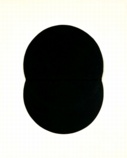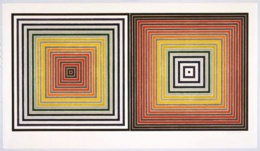

Precursors to Minimalism include the Russian Suprematists, such as Kasimir Malevich (Russian, 1878-1935). Examples:

Kasimir Malevitch, Black Cross, 1915, oil
on canvas, 80 x 79.5 cm,
Georges Pompidou Center, Paris. See Russian
art.

Kasimir Malevitch, Black Square, c. 1923-1930, oil
on plaster,
36.7 x 36.7 x 9.2 cm, Georges Pompidou Center, Paris.
Examples of Minimalist work:
Listed chronologically by artist's birth year
Use ctrl-F (PC) or command-F (Mac) to search for a name
Barnett Newman (American, 1905-1970), The Third, 1962, oil on canvas, Walker Art Center, Minneapolis, MN. See zip.

Agnes Martin (American, 1912-2004), Untitled, 1963, red and violet ink
and graphite on off-white
wove paper, 33 x 33 cm
(sheet), Fine Arts Museums of San Francisco, CA.
Tony Smith (American, 1912-1981).
Ad Reinhardt (American, 1913-1967), Black Painting No. 34, 1964, oil on canvas, 60 1/4 x 60 1/8 inches (1.530 x 1.526 m), National Gallery of Art, Washington, DC. See Abstract Expressionism.
Anne Truitt (American, 1921-2004)

Ellsworth Kelly (American, 1923-), Study for White Plaque: Bridge Arch and Reflection,
1951, cut-and-pasted black papers,
20 1/4 x 14 1/4 inches (51.4 x 36.1 cm) (irregular), Museum of
Modern Art, NY.
![]()
Ellsworth Kelly, Eleven Panels, Kite II, 1952, oil
on canvas, 80 x 280 cm,
Georges Pompidou Center, Paris.

Ellsworth Kelly, Untitled, 1964, silkscreen print, 55.8 x 45.7 cm (image),
61 x 50.8 cm (sheet) inches, Fine Arts Museums of San Francisco,
CA.

Ellsworth Kelly, Yellow Red Curve, 1972, oil
on canvas, 115 x 302 cm,
Georges Pompidou Center, Paris. See triangle.
![]()
François Morellet (French, 1926-),
6 chance divisions of 4 black and white squares
from odd and even numbers generated by Pi, 1958, oil on wood, 80 x 80 cm, Georges
Pompidou Center, Paris. See pi.
Donald Judd (American, 1928-1994), Untitled, 1967, stainless steel and Plexiglas, ten units, 9 1/8 x 40 x 31 inches, Modern Art Museum of Fort Worth, TX. See more of Judd's work at the site of his Chinati Foundation. Also see rectangle and specific objects.

Sol LeWitt (American, 1928-), Untitled, 1971, intaglio
print on paper,
image: 15.9 x 37.5 cm, Tate Gallery, London.

Sol LeWitt, Two Open Modular Cubes/Half-Off, 1972,
enamelled aluminum,
160.0 x 305.4 x 233.0 cm, Tate Gallery, London.
Sol LeWitt, Incomplete Open Cube #7-18, 1974, painted metal, Bayly Art Museum at the University of Virginia.

Sol LeWitt, Five Open Geometric Structures, 1979,
painted wood, 92.0 x 6720 x 91.4
cm, Tate Gallery, London.
Sol LeWitt, Complex Form #4, 1987, painted aluminum, New Britain Museum of American Art, CT.
Sol LeWitt, 463 works in the collection of the Fine Arts Museums of San Francisco, CA.
Robert Morris (American, 1931-)
Dan Flavin (American, 1933-1996), Icon VII (via crucis), 1962-64, fluorescent light and Masonite, 25 x 25 x 10 1/8 inches, Modern Art Museum of Fort Worth, TX. See light.
Carl Andre (American, 1935-), 144 Pieces of Zinc (144 Zinc Square), 1967, zinc plates, 144 x 144 x 3/8 inches (365.7 x 365.7 x 6.6 cm), Milwaukee Art Museum, WI.
Carl Andre, Tomb of the Golden Engenderers, 1976, western red cedar wood, x 274.3 [sic], Detroit Institute of Arts, MI. See wood.

Eva Hesse (American, born Germany, 1936-1970),
Tomorrow's Apples (5 in White), 1965,
enamel, gouache and mixed
media on board, 65.4 x 55.6 x 15.9 cm, Tate Gallery, London.
See Minimalism
and Post-Minimalism.
Eva Hesse, Hang Up, 1966, acrylic on cord and cloth, wood, and steel, 182.9 x 213.4 x 198.1 cm, Art Institute of Chicago.
Eva Hesse, Accession II, 1967, galvanized steel and rubber tubing, 78.1 x 78.1 x 78.1 cm, Detroit Institute of Arts, MI.

Eva Hesse, Addendum, 1967, painted papier
mâché, wood
and cord, 12.4 x 302.9 x 20.6 cm, Tate Gallery, London.

Eva Hesse (American, born Germany, 1936-1970),
Sans II, 1968, fiberglass,
38 x 170 3/4 x 6 1/8 inches (96.5 x 433.7 x 15.6 cm), Whitney
Museum of American Art, NY. See feminism
and feminist art, fluted,
and rectangle.

Eva Hesse, Contingent , 1969, cheesecloth, latex,
fiberglass, installation
(variable) 350.0 x 630.0 x 109.0 cm, National Gallery of Australia,
Canberra.

Frank Stella (American, 1936-), Hyena Stomp, 1962, oil
on canvas, 195.6 x 195.6
cm, Tate Gallery, London. See square.

Frank Stella, Mas o Menos (More or Less), 1964, metallic
powder in acrylic emulsion
on canvas, 300 x 418 cm,
Georges Pompidou Center, Paris.

Frank Stella, Tahkt-I-Sulayman Variation II, 1969,
acrylic on canvas,
120 x 240 inches, Minneapolis Institute of Arts. See protractor.

Frank Stella, Double Gray Scramble, 1973, screenprint, composition: 23 3/8 x 43 1/8 inches (59.4 x 109.5 cm); sheet: 29 x 50 3/4 inches (73 x 128.9 cm); edition: 100; publisher and printer: Gemini G.E.L., Los Angeles; collection Museum of Modern Art, NY. See concentric.

Richard Serra (American, 1939-), Prop, 1968, lead
antimony alloy,
97 1/2 x 60 x 43 inches (247.7 x 152.4 x 109.2 cm), Whitney Museum
of American Art, NY.

Richard Serra, 2-2-1: To Dickie and Tina, 1969, 1994,
lead antimony
alloy, 132.0 x 349.0 x
132.0 cm, Tate Gallery, London.

Richard Serra, Five Plates, Two Poles, 1971, Cor-ten
steel, 96 x 276 x 216 inches, Walker Art Center, Minneapolis,
MN.Richard Serra, Mozarabe, 1971, steel, x 76.2 inches wide, Detroit Institute
of Arts, MI.

![]()

Richard Serra, Tilted Arc, 1981, Cor-ten steel, 12 x 120 feet, New York City. See arc.

Richard Serra, Trip Hammer, 1988, steel, 274.3 x 331.5 x 134.6 cm, Tate Gallery,
London. See rectangle.

Richard Serra, Torqued Ellipse IV, 1998, weatherproof
steel, 12 feet 3
inches x 26 feet 6 inches x 32 feet 6 inches, (373.4 x 807.7
x 990.6 cm), Museum of Modern Art, NY.
Lynda Benglis (American, 1941-), Travel Agent, 1966/1977-78, pigmented beeswax and gesso on Masonite, 36 1/4 x 6 3/4 x 5 1/2 inches (92.1 x 17.1 x 14 cm), Whitney Museum of American Art, NY.
Keith Sonnier (American, 1941-), Abaca Code-Circles, 1975/1976, hand-cast paper and stamping, National Gallery of Art, Washington, DC.Ross Bleckner (American, contemporary).
Tony Cragg (English, 1949-)
Peter Halley (American, 1953-), A Perfect World, 1993, acrylic, day-glo acrylic, and Roll-a-Tex on canvas, 90 x 147 3/16 inches, Broad Art Foundation. Halley's style and period of Minimalism is generally known as Neo-Geo.
![]()
Also see communication, formalism, geometric, hard-edge, isms and -ism, postmodernism, and Post-Minimalism.
https://inform.quest/_art